Amorphous Poly (Aryl Ether Ketones) Containing Methylene Groups with Excellent Thermal Resistance, Dielectric Properties and Mechanical Performance
Abstract
:1. Introduction
2. Experiment
2.1. Materials
2.2. Synthesis of Monomer
2.2.1. Synthesis of BFB Monomer
2.2.2. Synthesis of DPFP Monomer
2.3. Synthesis of Polymers
2.4. Preparation of Films
2.5. Characterization
3. Results and Discussion
3.1. Structural Characterization
3.2. Thermal Properties
3.3. Mechanical Properties
3.4. Solubility Properties
3.5. Dielectric Properties
4. Conclusions
Supplementary Materials
Author Contributions
Funding
Institutional Review Board Statement
Data Availability Statement
Conflicts of Interest
References
- Ling, M.-Q.; Yu, K.-F.; Wang, J.; Wang, Z.-P.; Zhou, G.-Y. Design and synthesis of novel phenolphthalein-based poly (aryl ether) resin containing isopropyl groups. J. Mater. Res. Technol. 2022, 21, 153–260. [Google Scholar] [CrossRef]
- Li, Y.-H.; Sun, G.-H.; Zhou, Y.; Liu, G.-M.; Wang, J.; Han, S.-H. Progress in low dielectric polyimide film—A review. Prog. Org. Coat. 2022, 172, 107103. [Google Scholar] [CrossRef]
- Volksen, W.; Miller, R.D.; Dubois, G. Low dielectric constant materials. Chem. Rev. 2010, 110, 56–110. [Google Scholar] [CrossRef] [PubMed]
- Wang, Z.-Y.; Xie, Y.-R.; Shang, Y.-S.; Xu, D.; Jiang, Z.-L.; Xu, Q.-F.; Zhou, C.-Y.; Zhang, H.-B. Preparation and Properties of Novel Cross-Linked Fluorinated Poly(aryl ether) with Low Dielectric Constant and High Thermal Stability. Macromol. Rapid. Common. 2020, 41, 2000100. [Google Scholar] [CrossRef]
- Cao, T.; Shi, Y.-F.; Li, X.-Y.; Peng, J.; Liu, X.-B.; Huang, Y.-M. Dual cross-linking strategy to prepare fluorine-containing poly(arylene ether nitrile) films with a low dielectric constant and ultra-low water uptake. Polym. Chem. 2022, 13, 6213–6222. [Google Scholar] [CrossRef]
- Guan, X.-H.; Ma, Z.-F.; Xiang, Z.-H.; Ke, Y.; Xia, Y.; Nie, H.-R.; Zhou, G.-Y.; Shi, Q.; Yin, J.-H. Soluble polyarylate with high thermal stability and low-k at high frequency. Mater. Lett. 2022, 324, 132789. [Google Scholar] [CrossRef]
- Hu, Z.-D.; Liu, X.-Q.; Ren, T.-L.; Saeed, H.M.; Wang, Q.; Cui, X.; Huai, K.; Huang, X.-H.; Xia, Y.-M.; Fu, K.; et al. Research progress of low dielectric constant polymer materials. J. Polym. Eng. 2022, 42, 677–687. [Google Scholar] [CrossRef]
- Sparnacci, K.; Antonioli, D.; Deregibus, S.; Laus, M.; Poggio, T.; Kapeliouchko, V.; Palamone, G.; Zuccheri, G.; Passeri, R. PTFE-Based Core-Soft Shell Nanospheres and Soft Matrix Nanocomposites. Macromolecules 2009, 42, 3518–3542. [Google Scholar] [CrossRef]
- Zhao, P.-F.; Soin, N.; Prashanthi, K.; Chen, J.-K.; Dong, S.-R.; Zhou, E.-P.; Zhu, Z.-G.; Narasimulu, A.A.; Montemagno, C.D.; Yu, L.-Y.; et al. Emulsion Electrospinning of Polytetrafluoroethylene (PTFE) Nanofibrous Membranes for High-Performance Triboelectric Nanogenerators. ACS Appl. Mater. Interfaces 2018, 10, 5880–5891. [Google Scholar] [CrossRef]
- Ono, H.; Araoka, M.; Hirai, N.; Hirai, N. Factors influencing the dielectric properties of linear low-density polyethylene. Electr. Eng. Jpn. 2002, 140, 1–7. [Google Scholar] [CrossRef]
- Martin, S.J.; Godschalx, J.P.; Mills, M.E.; Shaffer, E.O.; Townsend, P.H. Development of a low-dielectric-constant polymer for the fabrication of integrated circuit interconnect. Adv. Mat. 2000, 12, 1769–1778. [Google Scholar] [CrossRef]
- Takahashi, S.; Imai, Y.; Kan, A.; Hotta, Y.; Ogawa, H. Preparation and characterization of isotactic polypropylene/MgO composites as dielectric materials with low dielectric loss. J. Ceram. Soc. Jpn. 2013, 121, 606–610. [Google Scholar] [CrossRef]
- Li, C.-Q.; Zha, J.-W.; Long, H.-Q.; Wang, S.-J.; Zhang, D.-L.; Dang, Z.-M. Mechanical and dielectric properties of graphene incorporated polypropylene nanocomposites using polypropylene-graft-maleic anhydride as a compatibilizer. Compos. Sci. Technol. 2018, 153, 111–118. [Google Scholar] [CrossRef]
- Bao, F.; Liu, Y.-X.; Shi, L.-D.; Cui, J.-Z.; Ji, M.-W.; Liu, H.-C.; Yu, J.-L.; Zhu, C.-Z.; Xu, J. Non-Coplanar Diphenyl Fluorene and Weakly Polarized Cyclohexyl Can Effectively Improve the Solubility and Reduce the Dielectric Constant of Poly (Aryl Ether Ketone) Resin. Polymers 2023, 14, 962. [Google Scholar] [CrossRef]
- Bao, F.; Zhang, F.-F.; Wang, C.-H.; Song, Y.-Y.; Li, N.; Wang, J.-Y.; Jian, X.-G. Study of the Effects of the Structure of Phthalazinone’s Side-Group on the Properties of the Poly(phthalazinone ether ketone)s Resins. Polymers 2019, 11, 803. [Google Scholar] [CrossRef]
- Liu, X.-L.; Sun, Y.-L.; Chen, Y.; Zhao, Z.-F.; Wang, Z.-P.; Zhou, G.-Y. Design and synthesis of novel poly (aryl ether ketones) containing trifluoromethyl and trifluoromethoxy groups. Des. Monomers. Polym. 2023, 26, 140–149. [Google Scholar] [CrossRef]
- Liu, Q.; Zhang, S.-H.; Wang, Z.-Q.; Li, N.; Chen, Y.-N.; Xu, P.-Q.; Jian, X.-G. Poly(aryl ether ketone ketone)s containing diphenyl-biphthalazin-dione moieties with excellent thermo-mechanical performance and solubility. Eur. Polym. J. 2021, 143, 110205. [Google Scholar] [CrossRef]
- Liu, X.; Zhang, X.-Z.; Jiang, J.-W.; Jia, H.-G.; Wang, J.-Y. Synthesis and Characterization of a Self-Polycondensation Diazaphthalanone Monomer and Its Polymers from Polycondensation Reactions. Polymers 2022, 14, 3904. [Google Scholar] [CrossRef] [PubMed]
- Marestin, C.; Chatti, S.; Mercier, R. Synthesis of poly(aryl ether)s bearing phosphonated side-chains from phosphonate ester-containing bisphenols. Polymer 2021, 222, 123647. [Google Scholar] [CrossRef]
- Gu, Y.-Y.; Ru, C.-Y.; Zhao, Z.; Chao, D.-M.; Liu, X.-C. Performance enhancement of shape memory poly(aryl ether ketone) via photodimerization of pendant anthracene units. Eur. Polym. J. 2020, 123, 109413. [Google Scholar] [CrossRef]
- Zhang, Y.-H.; Geng, Z.; Niu, S.; Zhang, S.-L.; Luan, J.-S.; Wang, G.-B. Preparation and applications of low-dielectric constant poly aryl ether. Adv. Ind. Eng. Polym. Res. 2020, 3, 175–185. [Google Scholar] [CrossRef]
- Grosso, D.; Boissiere, C.; Sanchez, C. Ultralow-dielectric-constant optical thin films built from magnesium oxyfluoride vesicle-like hollow nanoparticles. Nat. Mater. 2007, 6, 572–575. [Google Scholar] [CrossRef] [PubMed]
- Kannan, R.Y.; Salacinski, H.J.; Butler, P.E.; Seifalian, A.M. Polyhedral oligomeric silsesquioxane nanocomposites: The next generation material for biomedical applications. Acc. Chem. Res. 2005, 38, 879–884. [Google Scholar] [CrossRef]
- Zhao, X.-Y.; Liu, H.-J. Review of polymer materials with low dielectric constant. Polym. Int. 2010, 59, 597–606. [Google Scholar] [CrossRef]
- Ling, M.-Q.; Yu, K.-F.; Wang, J.; Wang, H.-H.; Nie, H.-R.; Wang, Z.-P.; Zhou, G.-Y. Synthesis and properties of low dielectric constant phenolphthalein-based poly (aryl ether) resin containing isopropyl groups. Mater. Lett. 2022, 311, 131547. [Google Scholar] [CrossRef]
- Liu, B.-W.; Long, J.-W.; Chen, L.; Xiao, X.-X.; Lin, X.-B.; Wang, Y.-Z. Semi-aromatic polyamides containing fluorenyl pendent toward excellent thermal stability, mechanical properties and dielectric performance. Polymer 2021, 224, 123757. [Google Scholar] [CrossRef]
- Qian, C.; Fan, Z.-G.; Zheng, W.-W.; Bei, R.-X.; Zhu, T.-W.; Liu, S.-W.; Chi, Z.-G.; Aldred, M.P.; Chen, X.-D.; Zhang, Y.; et al. A Facile Strategy for Non-fluorinated Intrinsic Low-k and Low-loss Dielectric Polymers: Valid Exploitation of Secondary Relaxation Behaviors. Chin. J. Polym. Sci. 2020, 38, 213–219. [Google Scholar] [CrossRef]
- Zhu, L.-Y.; Zong, L.-S.; Wang, C.-H.; Liu, X.-L.; Yuan, B.; Wang, J.-Y.; Jian, X.-G. Effect of di-halogen monomers embraced in main chain of low-dielectric colorless fluorene-based poly(aryl ether)s on their performance. Polym. Adv. Technol. 2022, 33, 1846–1854. [Google Scholar] [CrossRef]
- Kortet, S.; Claraz, A.; Pihko, P.M. Catalytic Enantioselective Total Synthesis of (+)-Lycoperdic Acid. Org. Lett. 2020, 22, 3010–3013. [Google Scholar] [CrossRef]
- Penn, S.J.; Alford, N.M.; Templeton, A.; Wang, X.R.; Xu, M.S.; Reece, M.; Schrapel, K. Effect of porosity and grain size on the microwave dielectric properties of sintered alumina. J. Am. Ceram. Soc. 1997, 80, 1885–1888. [Google Scholar] [CrossRef]
- Hougham, G.; Tesoro, G.; Viehbeck, A.; Chapplesokol, J.D. Polarization Effects of Fluorine on the Relative Permittivity in Polyimides. Macromolecules 1994, 27, 5964–5971. [Google Scholar] [CrossRef]
- Burgess, S.K.; Leisen, J.E.; Kraftschik, B.E.; Mubarak, C.R.; Kriegel, R.M.; Koros, W.J. Chain Mobility, Thermal, and Mechanical Properties of Poly(ethylene furanoate) Compared to Poly(ethylene terephthalate). Macromolecules 2014, 47, 1383–1391. [Google Scholar] [CrossRef]
- Liu, Q.; Zhang, S.-H.; Wang, Z.-Q.; Chen, Y.-N.; Jian, X.-G. Effect of pendent phenyl and bis-phthalazinone moieties on the properties of N-heterocyclic poly(aryl ether ketone ketone)s. Polymer 2020, 198, 122525. [Google Scholar] [CrossRef]


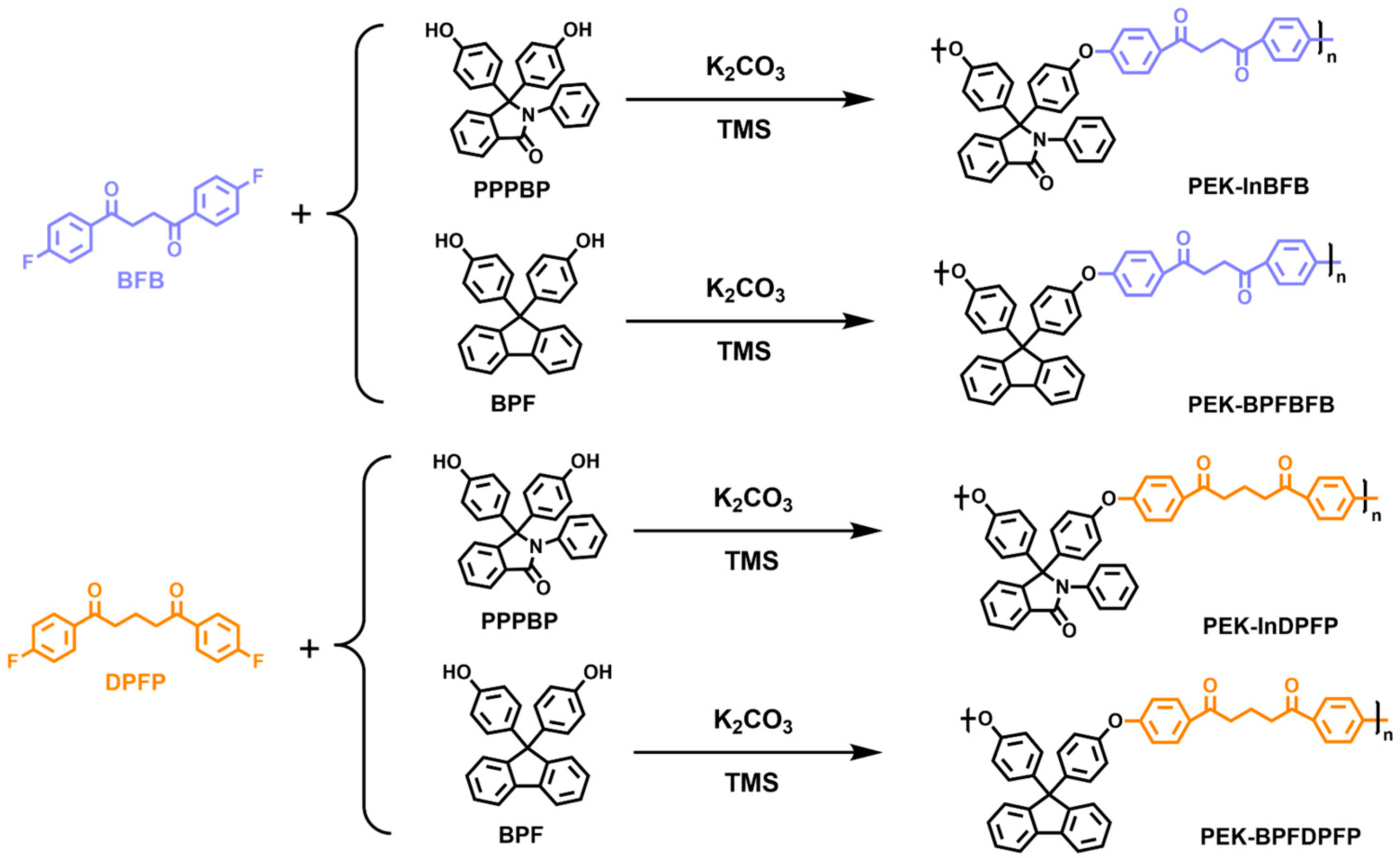

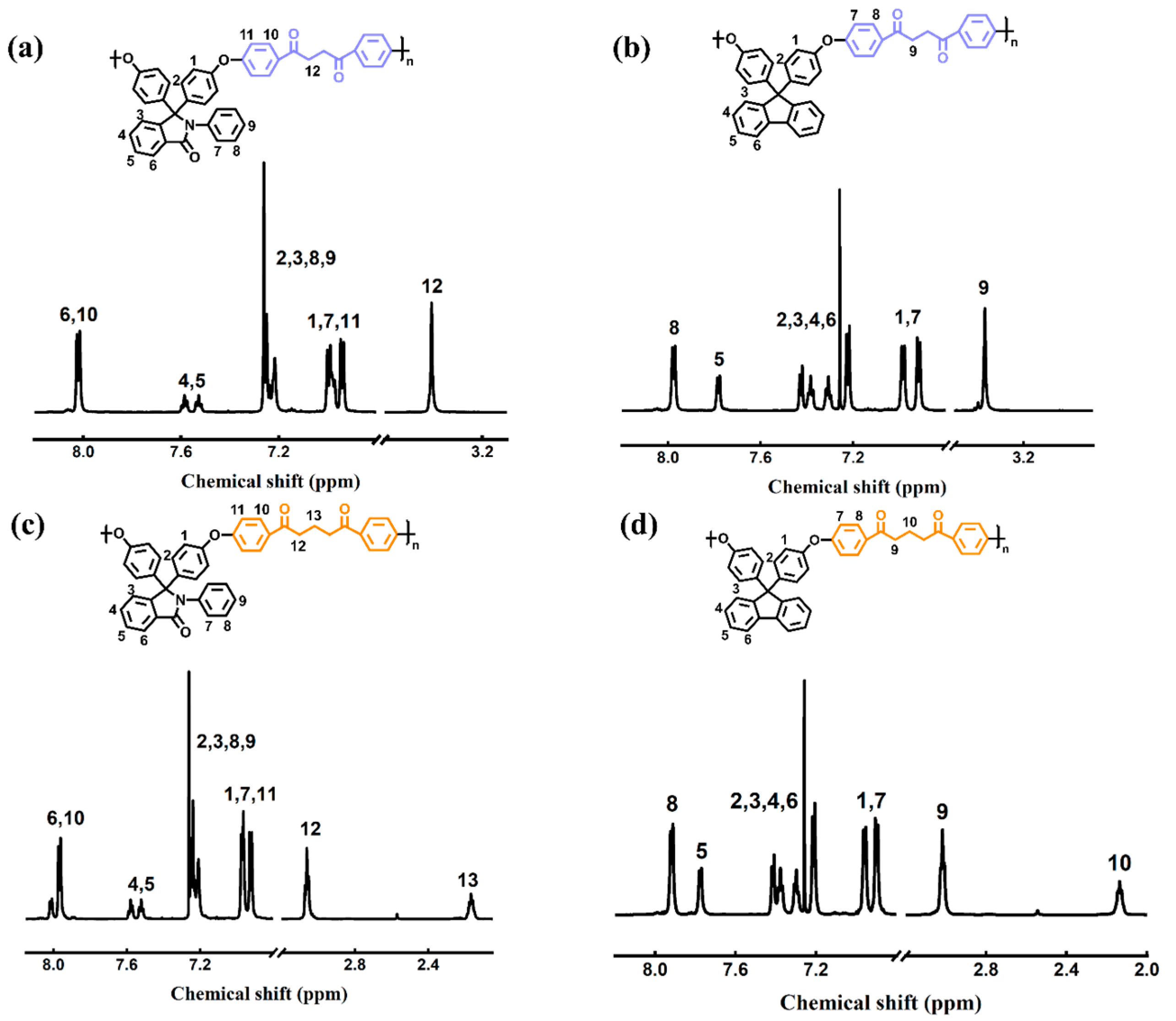

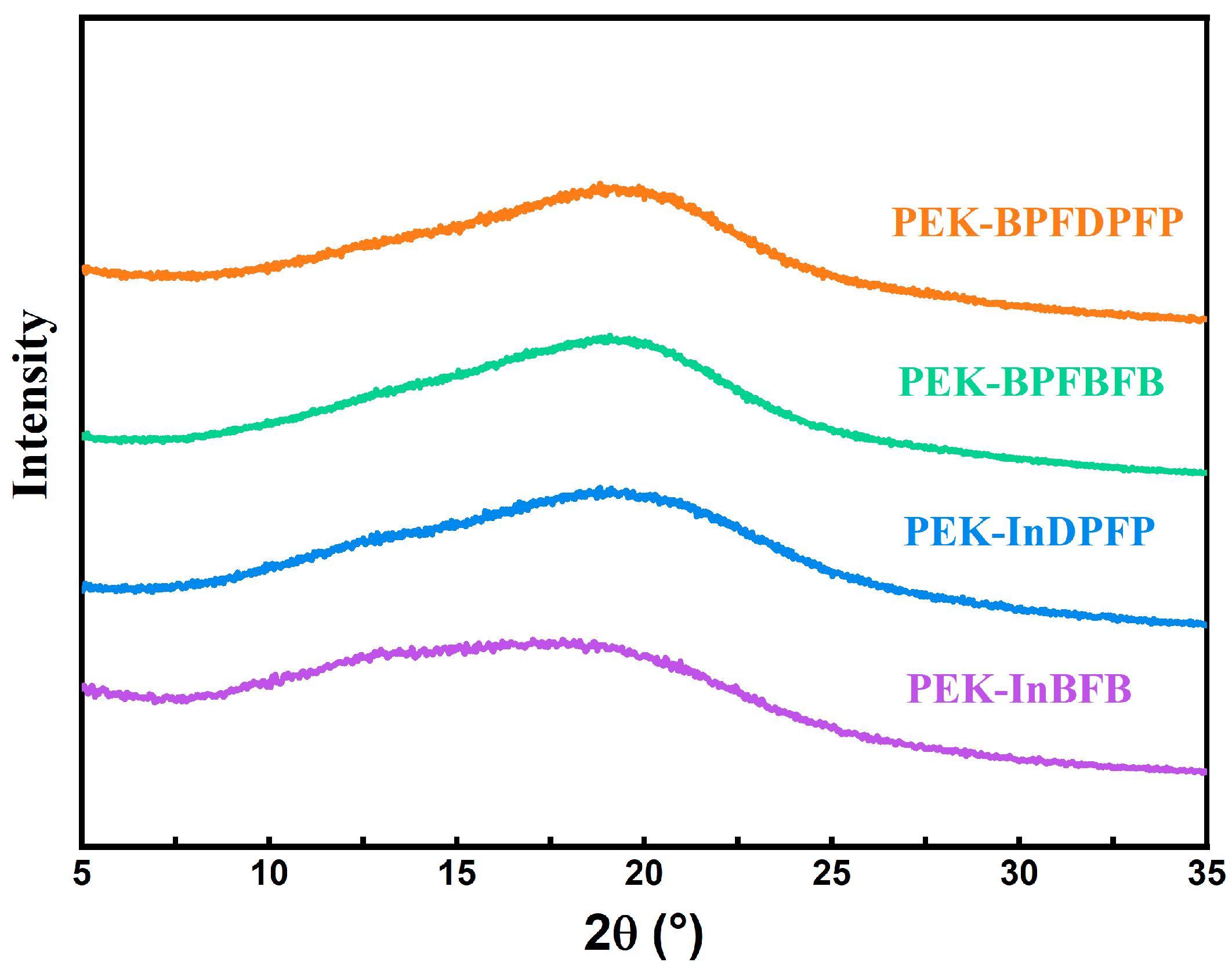


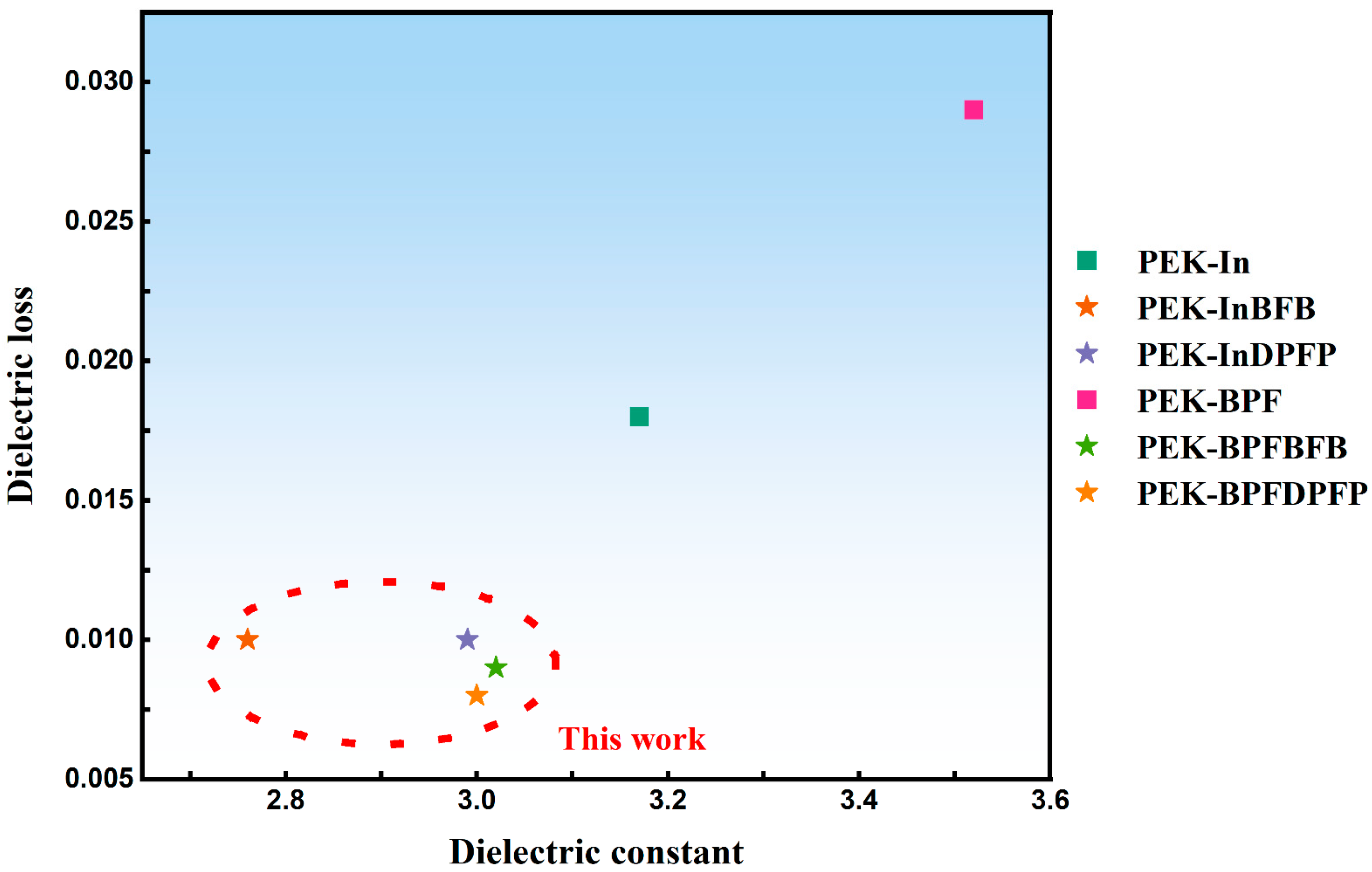
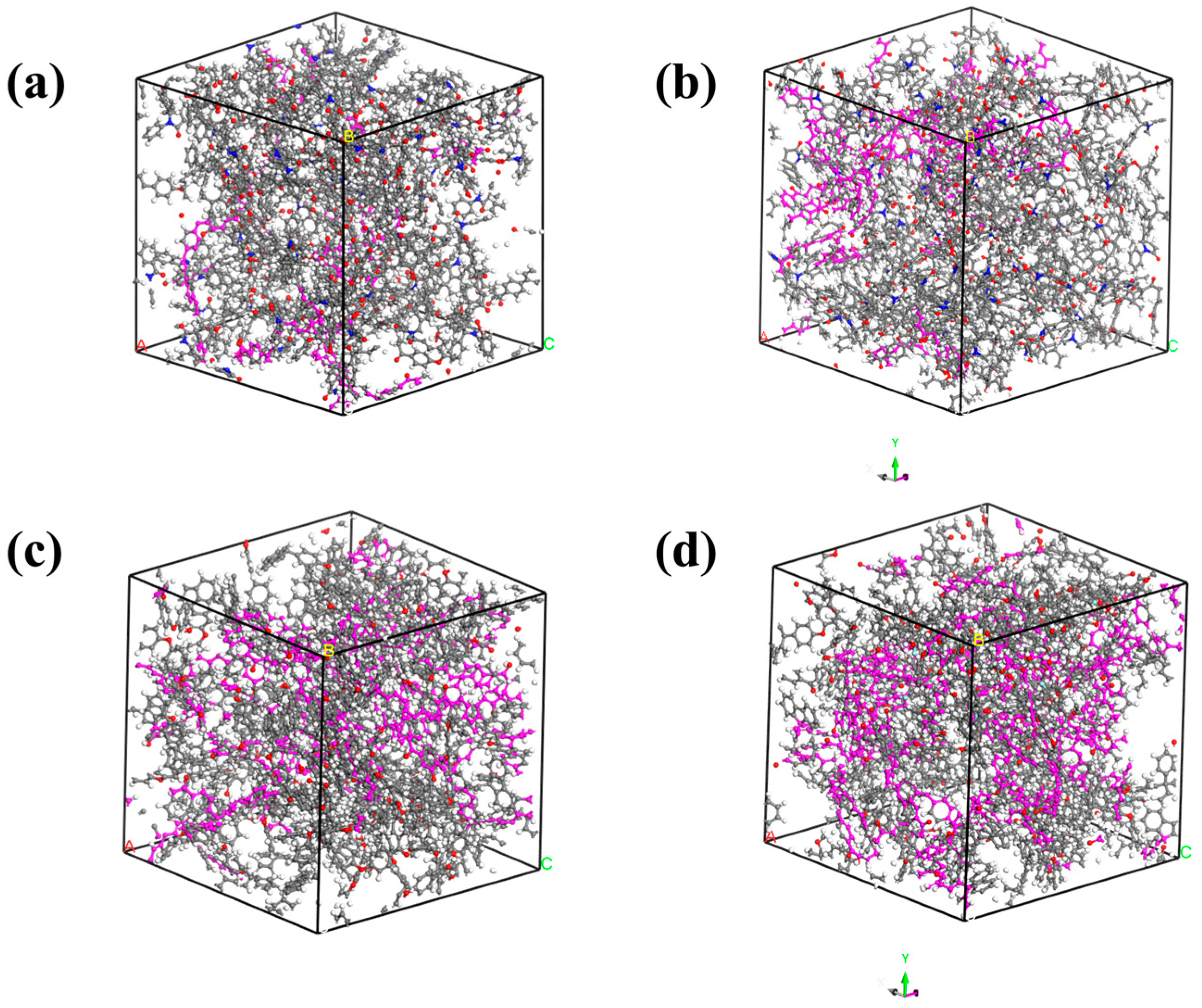
| Polymers | Monomers | Mn a (kDa) | Mw a (kDa) | PDI a | [η] b (dL/g) |
|---|---|---|---|---|---|
| PEK-InBFB | PPPBP + BFB | 30.2 | 53.1 | 1.76 | 0.45 |
| PEK-InDPFP | PPPBP + DPFP | 37.3 | 98.2 | 2.63 | 0.44 |
| PEK-BPFBFB | BPF + BFB | 32.6 | 69.2 | 2.13 | 0.38 |
| PEK-BPFDPFP | BPF + DPFP | 38.3 | 113.2 | 2.96 | 0.31 |
| Polymers | Td5% (°C) | Td10% (°C) | Cy700 °C (%) | Tg (°C) |
|---|---|---|---|---|
| PEK-InBFB | 434 | 462 | 57 | 216 |
| PEK-InDPFP | 418 | 441 | 48 | 192 |
| PEK-BPFBFB | 434 | 464 | 63 | 212 |
| PEK-BPFDPFP | 406 | 429 | 48 | 186 |
| Polymers | Young’s Modulus (GPa) | Tensile Strength (MPa) | Elongation at Break (%) |
|---|---|---|---|
| PEK-InBFB | 2.20 ± 0.18 | 88.5 ± 2.9 | 7.94 ± 1.19 |
| PEK-InDPFP | 2.17 ± 0.08 | 82.0 ± 3.0 | 7.55 ± 0.56 |
| PEK-BPFBFB | 2.21 ± 0.06 | 84.6 ± 1.2 | 6.79 ± 0.47 |
| PEK-BPFDPFP | 2.19 ± 0.08 | 83.1 ± 2.9 | 5.54 ± 0.17 |
| Polymers | Solubility a | |||||
|---|---|---|---|---|---|---|
| NMP | DMAc | DMF | CH2Cl2 | CHCl3 | EA | |
| PEK-InBFB | + | + | + | + | + | - |
| PEK-InDPFP | + | + | + | + | + | - |
| PEK-BPFBFB | + | + | + | + | + | - |
| PEK-BPFDPFP | + | + | + | + | + | - |
| Polymers | 10 GHz | |
|---|---|---|
| Dielectric Constant | Dielectric Loss | |
| PEK-In | 3.17 | 0.018 |
| PEK-InBFB | 2.76 | 0.010 |
| PEK-InDPFP | 2.99 | 0.010 |
| PEK-BPF [28] | 3.52 | 0.029 |
| PEK-BPFBFB | 3.02 | 0.009 |
| PEK-BPFDPFP | 3.00 | 0.008 |
| Polymers | Density (g cm−3) | Occupied Volume (Å3) | Free Volume (Å3) | FFV (%) |
|---|---|---|---|---|
| PEK-InBFB | 1.3 | 75,998.57 | 2493.76 | 3.18 |
| PEK-InDPFP | 1.3 | 78,480.52 | 1855.04 | 2.30 |
| PEK-BPFBFB | 1.3 | 70,892.95 | 4236.54 | 5.64 |
| PEK-BPFDPFP | 1.3 | 72,888.09 | 4033.12 | 5.24 |
Disclaimer/Publisher’s Note: The statements, opinions and data contained in all publications are solely those of the individual author(s) and contributor(s) and not of MDPI and/or the editor(s). MDPI and/or the editor(s) disclaim responsibility for any injury to people or property resulting from any ideas, methods, instructions or products referred to in the content. |
© 2023 by the authors. Licensee MDPI, Basel, Switzerland. This article is an open access article distributed under the terms and conditions of the Creative Commons Attribution (CC BY) license (https://creativecommons.org/licenses/by/4.0/).
Share and Cite
Jiang, J.; Wang, Z.; Sun, Y.; Qian, Z.; Cao, Z.; Wang, Z.; Zhou, G. Amorphous Poly (Aryl Ether Ketones) Containing Methylene Groups with Excellent Thermal Resistance, Dielectric Properties and Mechanical Performance. Polymers 2023, 15, 4330. https://doi.org/10.3390/polym15214330
Jiang J, Wang Z, Sun Y, Qian Z, Cao Z, Wang Z, Zhou G. Amorphous Poly (Aryl Ether Ketones) Containing Methylene Groups with Excellent Thermal Resistance, Dielectric Properties and Mechanical Performance. Polymers. 2023; 15(21):4330. https://doi.org/10.3390/polym15214330
Chicago/Turabian StyleJiang, Jingwei, Zhichao Wang, Yunlong Sun, Zengxu Qian, Zengwen Cao, Zhipeng Wang, and Guangyuan Zhou. 2023. "Amorphous Poly (Aryl Ether Ketones) Containing Methylene Groups with Excellent Thermal Resistance, Dielectric Properties and Mechanical Performance" Polymers 15, no. 21: 4330. https://doi.org/10.3390/polym15214330
APA StyleJiang, J., Wang, Z., Sun, Y., Qian, Z., Cao, Z., Wang, Z., & Zhou, G. (2023). Amorphous Poly (Aryl Ether Ketones) Containing Methylene Groups with Excellent Thermal Resistance, Dielectric Properties and Mechanical Performance. Polymers, 15(21), 4330. https://doi.org/10.3390/polym15214330





